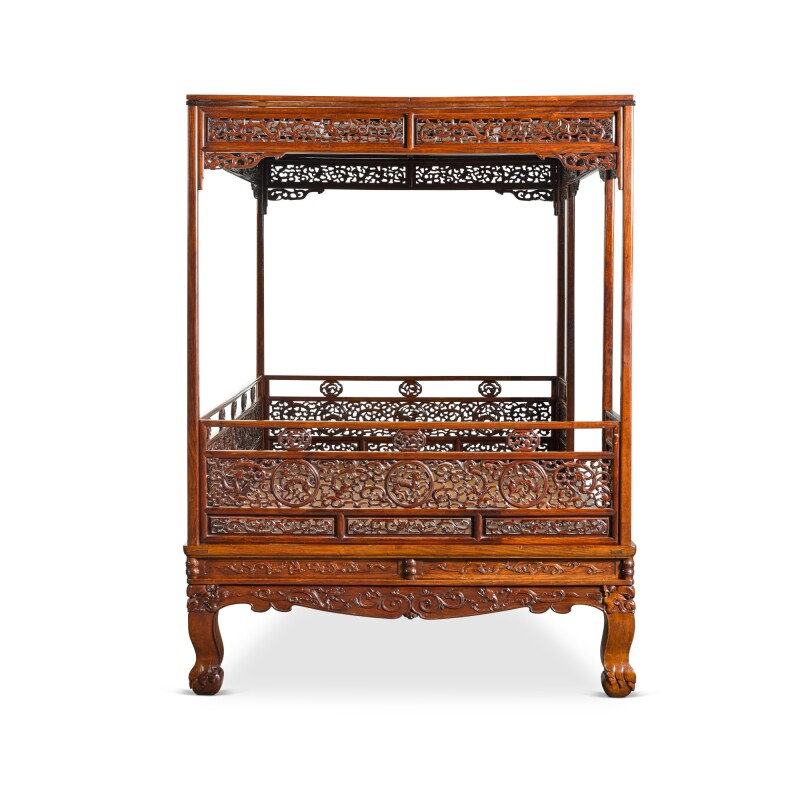An exceptional and rare Huanghuali six-post canopy bed (Jiazichuang), Late Ming dynasty
Lot 40. An impressive pair of large huanghuali and camphor wood compound cabinets (Sijiangui), Late Ming dynasty; 225.5 by 155 by 206.5 cm, 88¾ by 61 by 81¼ in. Lot sold: 478,800 GBP (Estimate: 400,000 - 600,000 GBP). © 2022 Sotheby's.
well proportioned, the wide rectangular frame enclosing a soft-mat sleeping surface surmounting a constricted waist carved with pairs of confronting chilong divided by short bamboo-form struts, above a shaped apron carved in low relief with stylised dragons striding amidst scrolling foliage, supported on four cabriole legs with animal masks at the shoulders ending in claw-and-ball feet, the six square section posts joined with five openwork panels forming a latticework gallery, each panel comprising three horizontal sections, the two front centre sections decorated with a qilin in a landscape, the side and back centre of conforming design with a ferocious lion alternating with medallions enclosing a qilin and a tripod censer, all between the top section with circular chilong roundels and the lower frieze with curling chilong, the top rail reticulated with similar chilong, the posts joined at the top by a canopy of corresponding form.
Provenance: Eastern Pacific Co. (Hei Hung-Lu), Hong Kong, 3rd September 1987.
Note: Sumptuously carved in openwork with auspicious motifs such as qilin, lions and chilong, this magnificent canopy bed displays late Ming (1368-1644) aristocratic splendour. As one of the most important pieces of furniture in a household, six-post canopy beds were among the most luxurious and impressive types of bed that one could own. Typically dressed with quilts and curtains, a canopy bed would have been used not just for sleeping at night, but also as a means of escape from daily life during the day.
Beds of this type are essentially a room within a room as their design reflects aesthetic principles of Chinese classical architecture. Their six-post construction mimics three-bay buildings such as pavilions, where the roof is supported by posts and the lack of walls merges outdoor and inner space. The sophisticated openwork railings recall a building’s balustrade, which have the dual function of creating interest through their decoration and increasing stability. In addition, the upper panels under the canopy roof are carved to allow air circulation like the panels under the eaves of buildings.
The furniture connoisseur Wang Shixiang, in the catalogue Masterpieces from the Museum of Classical Chinese Furniture, Chicago & San Francisco, 1995, p. 22, identifies a group of canopy beds exquisitely carved with closely related designs and suggests they were all produced at the same workshop in northern China. On display at San Antonio Museum of Art, Texas, for example, is a canopy bed (accession no. 65.111.34) closely related to the present piece, illustrated in the exhibition catalogue Beyond the Screen: Chinese Furniture of the 16th and 17th Centuries, Museum of Fine Arts, Boston, 2000, p. 59, fig. 2, where the Boston museum suggests that two similar examples are in the Great Mosque in Xian and the Palace Museum in Beijing.
Sotheby's. HOTUNG | 何東 The Personal Collection of the late Sir Joseph Hotung | Part II: Evening. London, 8 December 2022

/https%3A%2F%2Fprofilepics.canalblog.com%2Fprofilepics%2F1%2F0%2F100183.jpg)
/https%3A%2F%2Fstorage.canalblog.com%2F03%2F02%2F119589%2F96711876_o.jpg)
/https%3A%2F%2Fstorage.canalblog.com%2F11%2F31%2F119589%2F94773502_o.jpg)
/https%3A%2F%2Fstorage.canalblog.com%2F20%2F83%2F119589%2F94772815_o.jpg)
/https%3A%2F%2Fstorage.canalblog.com%2F26%2F72%2F119589%2F75604929_o.jpg)
/https%3A%2F%2Fstorage.canalblog.com%2F59%2F60%2F119589%2F26458628_o.jpg)











/image%2F1371349%2F20240409%2Fob_fc01a6_2024-nyr-22642-0899-000-a-rare-small-h.jpg)
/image%2F1371349%2F20240409%2Fob_1299ed_2024-nyr-22642-0898-000-a-rare-huanghu.jpg)
/image%2F1371349%2F20240403%2Fob_b08891_telechargement-4.jpg)
/image%2F1371349%2F20240403%2Fob_b24488_telechargement.jpg)